Key takeaways:
- Meditation encompasses various forms, such as mindfulness, loving-kindness, and movement-based practices like yoga, each providing unique pathways to self-awareness and inner peace.
- In religious contexts, meditation serves both personal and communal functions, fostering spiritual growth and ethical living.
- Key religious texts, such as the Bhagavad Gita and the Satipatthana Sutta, highlight the importance of focus and mindfulness in achieving spiritual enlightenment.
- Personal meditation experiences reveal insights into self-acceptance, emotional honesty, and enhanced intuition, illustrating the profound impact of mindfulness on daily life.
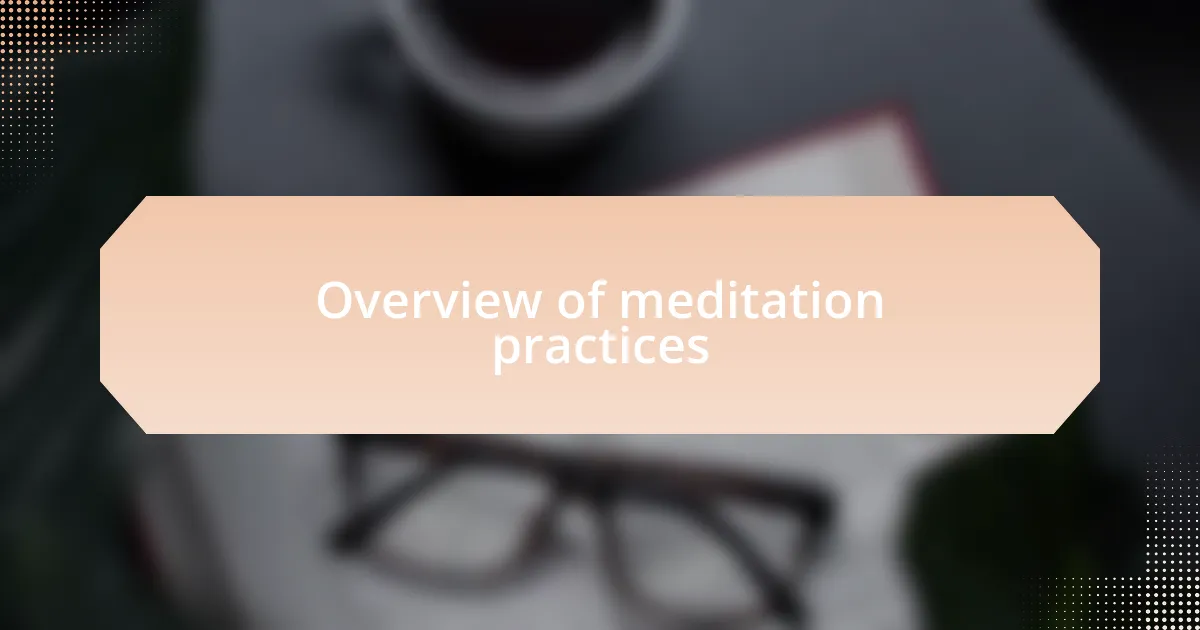
Overview of meditation practices
Meditation practices come in various forms, each offering unique pathways to self-discovery and inner peace. For instance, during my early explorations, I stumbled upon mindfulness meditation, where focusing on my breath created a profound sense of calm. It made me realize how often we overlook the simple act of breathing – how can something so fundamental hold such transformative power?
There’s also loving-kindness meditation, which encourages compassion toward oneself and others. I remember feeling a surge of warmth in my chest as I silently wished well for friends and family. This practice opened my eyes to the healing potential of love and kindness, prompting me to reflect on how often I hold back these feelings in everyday life.
On a more dynamic note, movement-based meditations, like yoga, have their own unique advantages. I vividly recall the feeling of my body flowing through poses, allowing my mind to quiet down. Isn’t it fascinating how engaging our physical self can lead to a deeper state of mental clarity? Each of these practices, whether silent or active, builds a bridge to a richer, more connected existence.
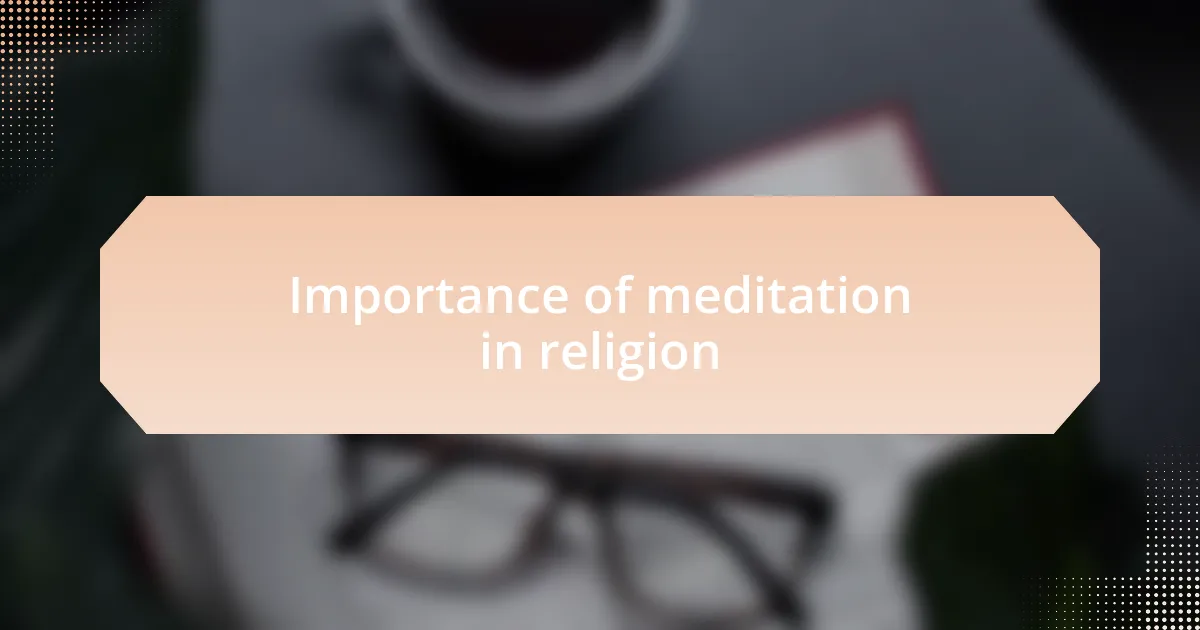
Importance of meditation in religion
Meditation holds a significant place in various religious traditions, often serving as a bridge to deeper spiritual understanding. I recall attending a retreat where chanting and silent reflection were intertwined, revealing to me how these practices create sacred space for connecting with the divine. Isn’t it profound how such rituals can foster a sense of community and shared purpose among practitioners?
In many religions, meditation is viewed not only as a personal journey but also as a communal practice that strengthens faith. During group meditations, I experienced an overwhelming sense of belonging, as if we were all tuning into a frequency of collective consciousness. Have you ever felt that energy in a room full of people, all focused on the same intention? It’s a powerful reminder that our spiritual paths often intertwine with those of others.
Moreover, the teachings underlying meditation in religious contexts encourage mindfulness and ethical living. I often reflect on how these principles pushed me to evaluate my actions and intentions more carefully. How do our thoughts and feelings influence our daily decisions? In this light, meditation becomes a tool for personal growth that extends beyond the mat or the cushion, shaping our interactions and relationships in meaningful ways.
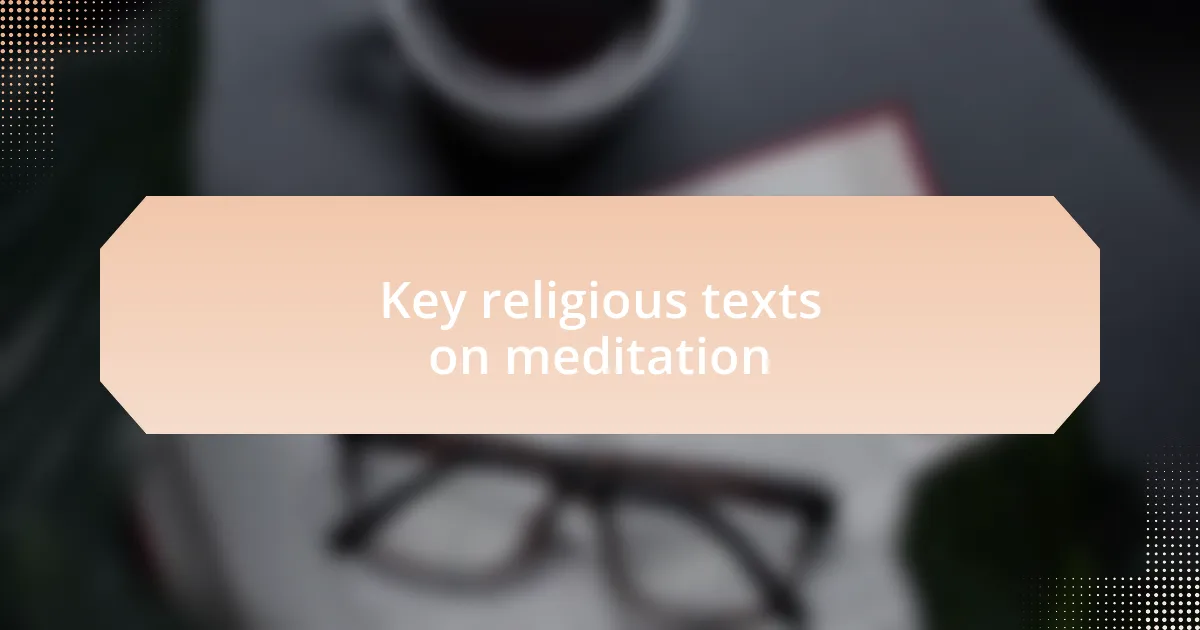
Key religious texts on meditation
The Bhagavad Gita, a cornerstone of Hindu philosophy, provides profound insights into meditation, illustrating its role in self-realization and spiritual enlightenment. I vividly recall reading about Arjuna’s internal struggle, where Krishna emphasizes the importance of focus and dedication on the path to understanding one’s true self. Have you ever considered how clear intention can transform a moment of doubt into clarity?
In Buddhist teachings, the Satipatthana Sutta serves as a fundamental text for mindfulness meditation. It outlines the Four Foundations of Mindfulness, guiding practitioners in observing their thoughts, emotions, and physical sensations without attachment. As I navigated through these passages, I found myself reflecting on my own distractions and how awareness can lead to deeper inner peace. Doesn’t it strike you how these ancient words remain relevant in today’s fast-paced world?
In the Christian tradition, texts like “The Cloud of Unknowing” emphasize contemplative prayer, where silence and stillness lead to divine encounter. I remember the quiet moments spent in deep reflection, where I felt utterly connected to something greater than myself. Isn’t it fascinating to think how this pursuit of divine connection through meditation has shaped the lives of countless believers throughout history?
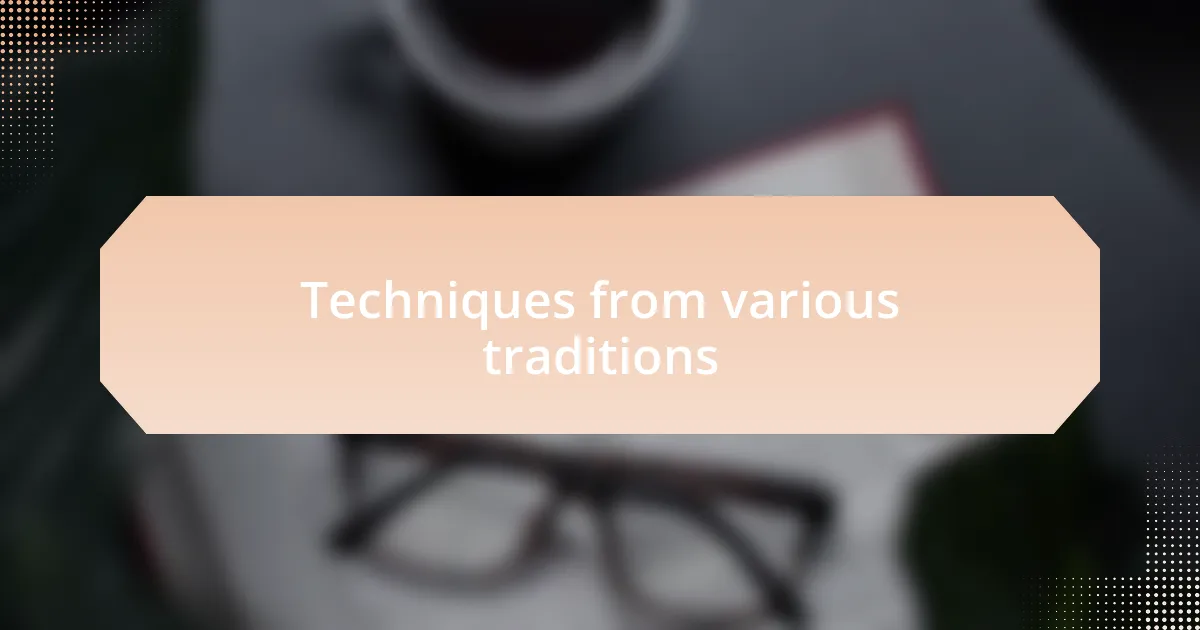
Techniques from various traditions
In my exploration of Sufi practices, I found the technique of Dhikr, or the remembrance of God, to be profoundly transformative. This rhythmic chanting and repetition of divine names create a meditative state that fosters deep connection and presence. I remember joining a Sufi gathering, where the group’s united chants enveloped me in a wave of serenity, making me question how communal energy can amplify personal spiritual experiences.
Taoist meditation offers a contrasting yet equally fascinating approach with its emphasis on naturalness and flow, particularly through techniques like Zhuangzi’s “Sitting and Forgetting.” This method encourages quieting the mind and aligning oneself with the natural world. I once spent an afternoon in a quiet park, trying this practice, which resulted in a powerful sense of ease and connection to my surroundings. Have you ever felt the peace that comes from just being, without any need to force thoughts away?
From the tradition of yoga, techniques such as Trataka or candle gazing stand out as intriguing tools for concentration. The practice involves simply focusing on the flame of a candle, allowing thoughts to settle and clarity to emerge. I vividly recall my first attempts at this; the flickering light drew me in, and after a few minutes, I felt as if layers of mental clutter had peeled away. Isn’t it remarkable how something as simple as watching a flame can lead to profound mental stillness?
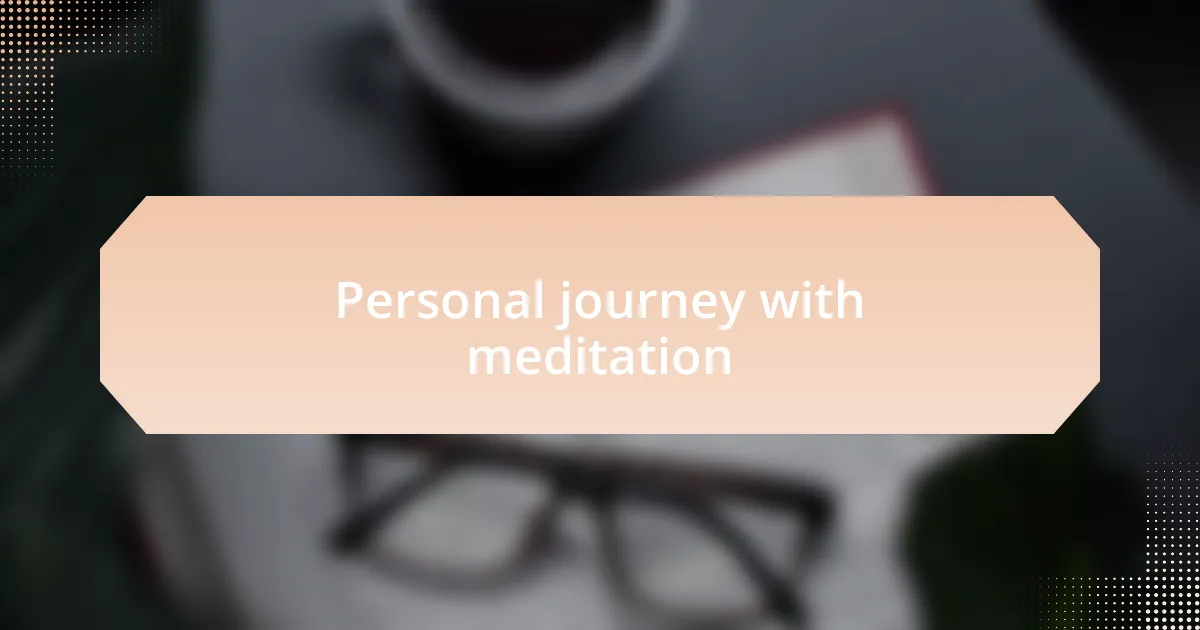
Personal journey with meditation
My personal journey with meditation unfolded unexpectedly one rainy afternoon, when I found myself sitting cross-legged on my living room floor, surrounded by scattered cushions. As I closed my eyes, I felt the gentle thrum of raindrops against the window, creating a natural rhythm that lulled me into a deeper state of awareness. In those moments, I recognized how the noise of the outside world could transform into a soothing backdrop, allowing me to hear the whispers of my own thoughts more clearly.
As I gained confidence in my practice, I began exploring guided meditations, which opened a new dimension of insight. One evening, while listening to a facilitator’s calming voice, I immersed myself in a visualization exercise that led me through a forest path filled with vibrant colors and textures. That experience was almost surreal; I emerged feeling rejuvenated, with a fresh perspective on the challenges I was facing. Have you ever felt that shift after losing yourself in a guided meditation, where the world seemed a little brighter and more manageable?
Over time, I developed a love for the simplicity of breath awareness meditation. I remember sitting on a park bench, feeling the sun warm my face as I focused solely on my breath. In those moments, I experienced a profound sense of release—not just from stress, but from the incessant chatter of self-doubt. It made me realize how vital these moments of stillness are in cultivating self-compassion. Have you taken a moment to breathe deeply today?
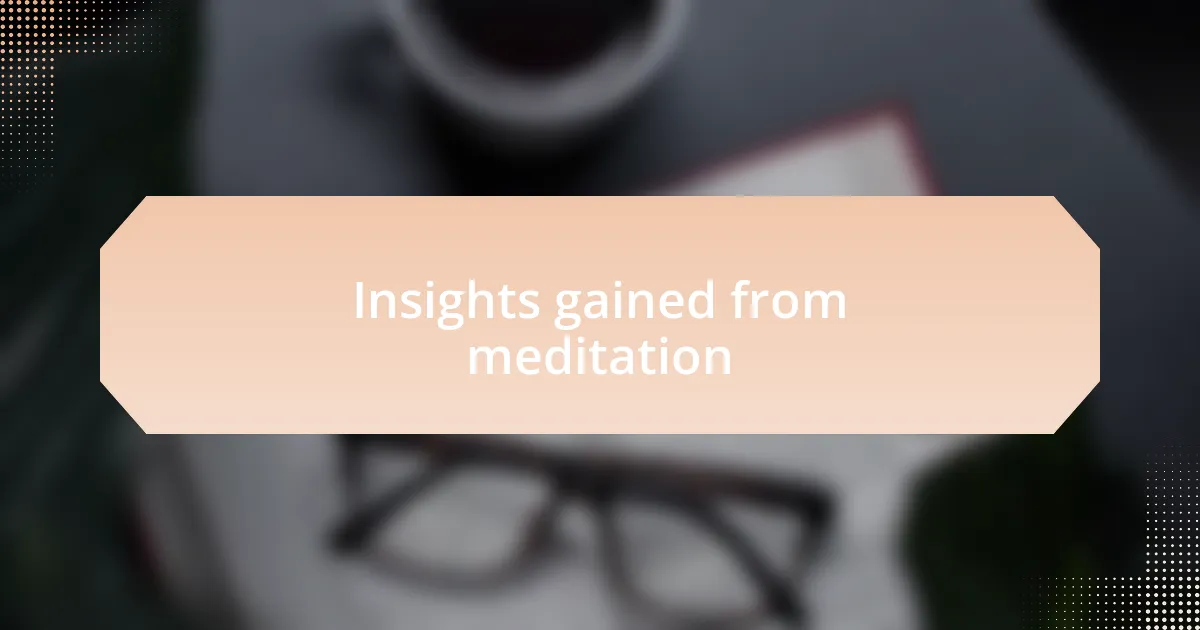
Insights gained from meditation
Each session of meditation has unveiled deeper layers of understanding about myself and my surroundings. I recall one particularly impactful morning when I decided to meditate outdoors under the vast sky. As birds sang and the wind whispered through the trees, I realized how interconnected we are with nature. This moment highlighted the power of mindfulness; I found that being present in the moment allowed me to appreciate the beauty around me in a way I’d never noticed before. Have you ever taken a moment to really look around you?
The insights gained through meditation also encouraged me to embrace vulnerability. One evening, during a session focusing on self-acceptance, I felt an overwhelming tide of emotion. I wept—not out of sadness but relief—as I acknowledged parts of myself I had long hidden away. This experience illuminated a crucial truth: healing begins when we confront our true selves. How often do we allow ourselves that kind of emotional honesty in our daily lives?
Additionally, I’ve noticed how meditation has sharpened my intuition. I remember a day when I had to make a challenging decision, pulling me in different directions. After a brief meditation session, I found clarity emerging from the stillness. Suddenly, the answer became apparent; it was as if the noise of indecision faded, revealing the path I needed to take. Have you ever experienced a moment where quiet reflection led you to a crucial realization?